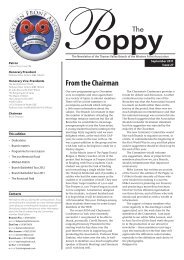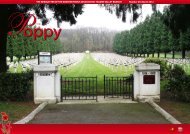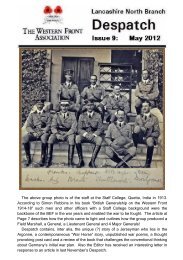Up_the_Line_July_2012.pdf - The Western Front Association
Up_the_Line_July_2012.pdf - The Western Front Association
Up_the_Line_July_2012.pdf - The Western Front Association
You also want an ePaper? Increase the reach of your titles
YUMPU automatically turns print PDFs into web optimized ePapers that Google loves.
S-D was aware of <strong>the</strong> aspects of modern warfare, including <strong>the</strong> effects<br />
of <strong>the</strong> Russo-Japanese War and modern ordnance and weaponry. In<br />
1915, <strong>the</strong> trenches were much more basic than <strong>the</strong> systems that evolved<br />
through 1916. <strong>The</strong> initial surprise of gas attacks meant defenders were to<br />
suffer more casualties than defenders, <strong>the</strong> reverse of later trends. <strong>The</strong> BEF<br />
in early 1915 was low in numbers and reservists were not up to scratch.<br />
If S-D can be criticised, it is over <strong>the</strong> failure to hold <strong>the</strong> Messines Ridge.<br />
Attacks to regain <strong>the</strong> ridge failed, leaving <strong>the</strong> Germans to dig in and enjoy<br />
<strong>the</strong> advantages of overlooking Ypres until June 1917. However <strong>the</strong> BEF was<br />
not alone in early offensives. <strong>The</strong> French suffered badly in an attempt on<br />
Vimy Ridge.<br />
In 1915, <strong>the</strong> BEF did not have sufficient resources to sustain serious<br />
offensives. Artillery really never met <strong>the</strong> criteria until 8th August 1918.<br />
Manpower relied on TA units coming in and later on <strong>the</strong> Service units.<br />
Failure was also to fall on <strong>the</strong> professional German Army. <strong>The</strong> Schliffen<br />
Plan was ultimately a failure. <strong>The</strong>ir plans were concentrated in <strong>the</strong> east.<br />
Initial gas experiments <strong>the</strong>re were unsuccessful due to freezing wea<strong>the</strong>r.<br />
In <strong>the</strong> west gas canisters required a north easterly wind, which was rarely<br />
experienced. <strong>The</strong> enemy had only basic masks and were reluctant to follow<br />
<strong>the</strong> gas. Thus <strong>the</strong> experimental nature of gas at Ypres. Never<strong>the</strong>less <strong>the</strong><br />
British and Empire troops were able to stem <strong>the</strong> threat. However, one of <strong>the</strong><br />
problems at second Ypres was <strong>the</strong> loss of many junior officers. Many were<br />
from public school OTCs and <strong>the</strong> losses took time to effectively replace.<br />
Overall, S-D suffered from <strong>the</strong> antagonism of Sir John French. <strong>Up</strong>on his<br />
taking over command of 2nd Army, Plumer came to <strong>the</strong> same conclusion<br />
as S-D. This time French accepted his commander’s decision. S-D was a<br />
good officer and historians generally accept that his main decisions were<br />
correct. Sir John French was clearly unsuited to high command. He was to<br />
be seen as failing at Loos. This opened <strong>the</strong> door for Haig to assume overall<br />
command. It is fortunate that he inherited an efficient officer in Plumer.<br />
An absorbing account of <strong>the</strong> battle and personal intrigues that dogged<br />
<strong>the</strong> BEF. S-D has been seen to have been harshly treated by French. Ed<br />
Captain GVS Bowlby<br />
Captain H L Skrine<br />
holds ninety-five graves, including two French soldiers. Many of <strong>the</strong> graves<br />
were destroyed by subsequent shellfire and only twenty-six actual graves<br />
are identified. <strong>The</strong> remainder have special memorial headstones.<br />
I <strong>the</strong>n headed up <strong>the</strong> road towards Hellfire Corner, calling in at Perth-<br />
China Wall Cemetery (III). This was originally used by <strong>the</strong> French, whose<br />
graves were removed after <strong>the</strong> Armistice. It was taken on, in 1917, by <strong>the</strong><br />
YPREs VISIT 14/18th May<br />
Part 2<br />
Having spent some time at Hooge Crater<br />
Cemetery, I continued on my walk. A path<br />
to <strong>the</strong> east of <strong>the</strong> cemetery follows <strong>the</strong> Old<br />
Bond Street Communication Trench (1). This<br />
brought me to <strong>the</strong> access road to Hill 62 (2). It<br />
was here that a counter attack attempted to<br />
regain <strong>the</strong> land gained in <strong>the</strong> German flame<br />
thrower attack on 30th <strong>July</strong> 1915. Two attacks<br />
failed at <strong>the</strong> cost of more than 450 casualties.<br />
2nd Lt Harry Rawlinson of <strong>the</strong> Rifle Brigade<br />
was awarded <strong>the</strong> VC and appears on <strong>the</strong><br />
Menin Gate.<br />
I returned to <strong>the</strong> Menin Road (3) and<br />
headed west. Shortly, on <strong>the</strong> nor<strong>the</strong>rn side is<br />
Cambridge Road. This formed <strong>the</strong> Birr Cross<br />
Roads, although <strong>the</strong> sou<strong>the</strong>rn road no longer<br />
exists. Both armies tunnelled here and <strong>the</strong><br />
British had dugouts and a dressing station.<br />
<strong>The</strong> name comes from <strong>the</strong> Leinsters’ depot in<br />
Ireland. A little fur<strong>the</strong>r on is <strong>the</strong> cemetery of<br />
Captain Harold Ackroyd<br />
that name (4). <strong>The</strong>re are 800 graves, including<br />
that of Captain Harold Ackroyd VC MC. He was <strong>the</strong> MO attached to 6Bn<br />
Royal Berkshires. He was killed by a sniper on 11 August 1917.<br />
I <strong>the</strong>n retraced my steps and walked up Cambridge Road, eventually<br />
crossing <strong>the</strong> N37, which was formerly <strong>the</strong> Ypres-Roulers railway line (5). On<br />
<strong>the</strong> side road are two private memorials to Captains from 1915. <strong>The</strong>se are<br />
Geoffrey Bowlby, Royal Horse Guards and Henry Skrine, 6Bn Somerset LI.<br />
Interspersed is a small wooden cross commemorating <strong>the</strong> Leicestershire<br />
Yeomanry on Frezenberg Ridge on 13 May 1915. I crossed back over <strong>the</strong><br />
N37 and followed <strong>the</strong> sou<strong>the</strong>rn edge of Railway Wood. This brought me<br />
to <strong>the</strong> RE Grave, Railway Wood. This marks <strong>the</strong> spot where 8th RE 177th<br />
Tunnelling Coy. and 4 soldiers were entombed underground on 25th<br />
September 1915.<br />
A mine had been blown in <strong>the</strong> early hours as 9Bn Rifle Brigade<br />
attacked. <strong>The</strong> 5Bn Oxs & Bucks and 5BN King’s Shropshire LI also attacked<br />
Bellewaarde Farm strong-point. <strong>The</strong> units all suffered heavily casualties.<br />
Nearby is <strong>the</strong> Liverpool Scottish Memorial which commemorates <strong>the</strong>ir<br />
attack on 16th June 1915. I <strong>the</strong>n followed <strong>the</strong> track back to <strong>the</strong> museum<br />
on <strong>the</strong> Menin Road.<br />
Being a glutton for punishment, I could not resist adding on a final stroll.<br />
I took <strong>the</strong> road adjoining Birr Cross Roads Cemetery (I) and eventually<br />
came to Tuilieres British Cemetery (II). This small picturesque cemetery<br />
Tuilieres British Cemetery<br />
Railway Wood<br />
2



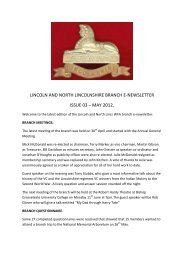

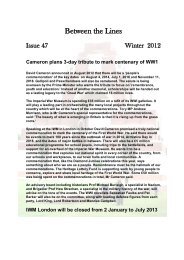

![Fromelles Australian Working List[1].pdf - The Western Front ...](https://img.yumpu.com/29972632/1/184x260/fromelles-australian-working-list1pdf-the-western-front-.jpg?quality=85)
